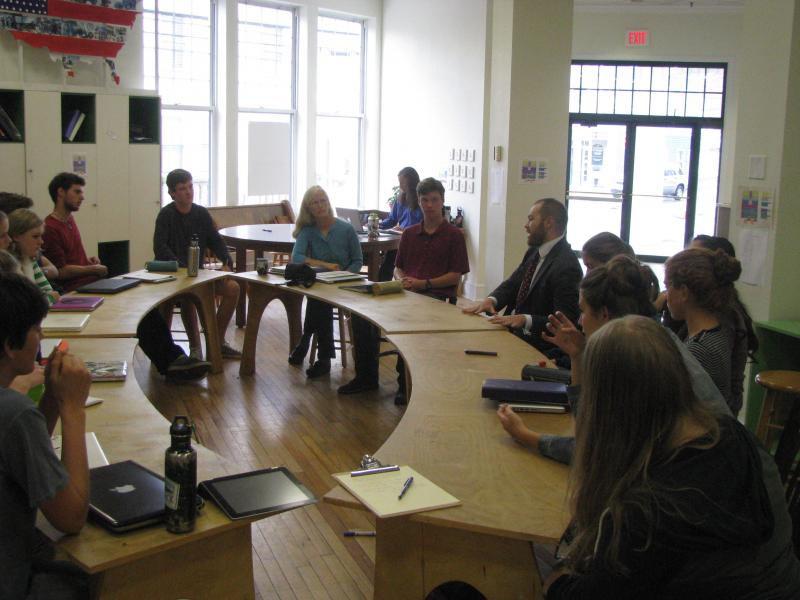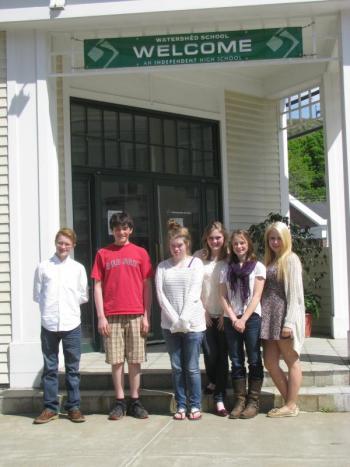Watershed School's global climate change class spent six weeks researching the question; What would it take for Maine to be carbon neutral by 2050? Their report was posted on the Maine Climate Solutions website and brought to the attention of Patrick Woodcock, director of the Governor's Energy Office. Woodcock was so impressed with the breadth, conclusions and high quality of the students' report that he asked to come to Watershed School to meet the authors and talk about their findings. The students' report and their hour long discussion with Patrick Woodcock are summarized below.
The students' findings and conclusions
The students' research involved several steps. After finding out how much energy Maine uses now, how much of that is coming from renewable energy sources, and how much energy Maine is expected to use in 2050, the class researched energy options that could be used instead of fossil fuels. As part of their research, they met with solar installers, energy auditors, experts on offshore wind, and scientists.
They came up with 16 carbon reduction options, all from technologies that are currently being used in New England or are in the research and development stage. They determined that it would take 9 of these options or "wedges" to replace the fossil fuel portion of Maine's energy "pie.” Any combination of nine wedges out of the 16 options, if phased in over the next three and a half decades, would result in a carbon neutral Maine (see attached table for a list of the options).
The students' concluded that Maine has more than enough renewable resources to become carbon neutral by 2050. They noted that the state has 30 percent more solar energy hitting our land than Germany, the world's leader in solar energy installations, and that Maine has hundreds of existing dormant dams that if developed could produce more energy than all the active ones put together. They also learned that Maine has one of the best wind resources in the world and the third best ocean energy resource in the United States. The wind and ocean energy alone are enough to power the state many times over.
In addition, Maine is 88 percent forested and waste wood is considered a carbon neutral energy source that can be used to produce electricity, heat and biofuel. The students acknowledged that the transition away from fossil fuels will not be easy because it will mean that what is now powered by oil will have to switch to electricity. This includes heating, cars, energy production, and more.
Common Ground and a Reality Check
The discussion with Woodcock centered around what steps to take first and the political realities and challenges of reducing dependence on fossil fuel. Woodcock agreed that there could be huge energy and cost savings from increasing the efficiency of residential and commercial buildings and that this was a good place to start. He emphasized the importance of finding the "easy steps" that both political parties could agree on and also the ones that individuals are most likely to do.
When asked about transportation, which accounts for the largest percentage of Maine's fossil fuel use, he did not think we would be tackling a shift from gas-powered to electric cars for another two to three decades. However, he did see a small role for mass transit, especially more bus routes, for example, between Portland and Lewiston. When asked if he thought nuclear power was an option in Maine, he thought that it was unlikely, given the high cost of building nuclear power plants and public attitudes.
Woodcock pointed out that conservation by individuals (simply using less) could play an important role in reducing Maine's energy consumption. He emphasized that it was important not just to change how much energy we use, but when we use it. For example, running dishwashers and washing machines at night instead of during the day, when power plants are producing peak loads, would reduce the overall amount of energy Maine needs to produce. He had an energy app on his iphone that showed how much power New England was using minute by minute to demonstrate how nighttime demand differed from daytime demand.
The students were particularly interested in long term solutions. One student asked if the state had a plan in place to become carbon neutral. While Woodcock emphasized the need for long-range thinking when it comes to energy investment and conservation, he acknowledged that there was no long-range plan in place. He pointed to the New England Regional Greenhouse Gas Initiative, a cap and trade program, that is helping cut emissions, but did not think things like a carbon tax, rebates for energy efficient cars, or building codes were the best options since these "would be used mostly by the affluent" or could have a negative impact on the poor. Several students suggested that lack of education was the reason for this, for example, energy efficient cars are cheaper to run and drive than SUVs and large trucks.
Another student asked Woodcock if he thought becoming carbon neutral by 2050 was possible. Woodcock used the Verso Mill closing in Bucksport as an example of the need to weigh jobs versus the environment. "We don't want to shut down mills to reduce emissions, " he said. The students pressed him on this, since a focus on energy efficiency would be more likely to help mils like Verso, and noted that it will only become more expensive to ignore the costs of a rapidly changing climate.
The students were encouraged that Woodcock was so knowledgeable on the issues and did not doubt that climate change was happening. However, they were disappointed to see how short term political interests are preventing the level of change that is needed to make their future more certain. The students consider global climate one of the biggest challenge their generation faces. Their goal, in writing the report, was to promote conversation on this critical topic and provide a broader sense of what is possible. Their conversation with Patrick Woodcock was a good start.
To read the full report, go to watershed-school.org

























